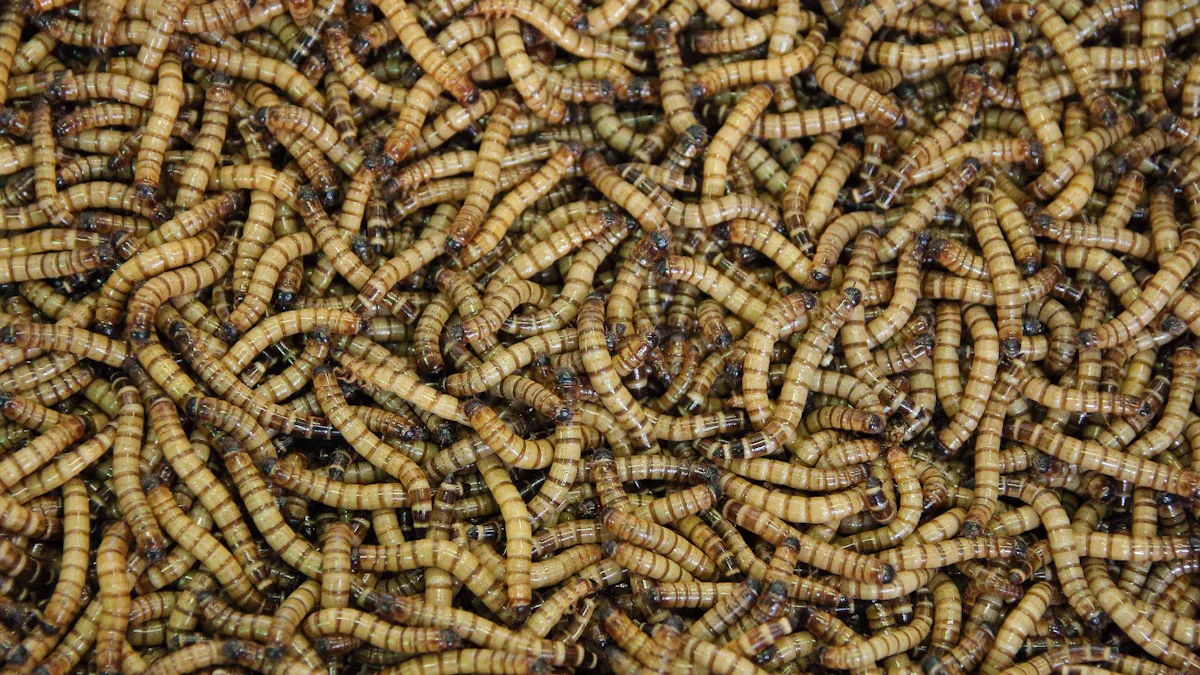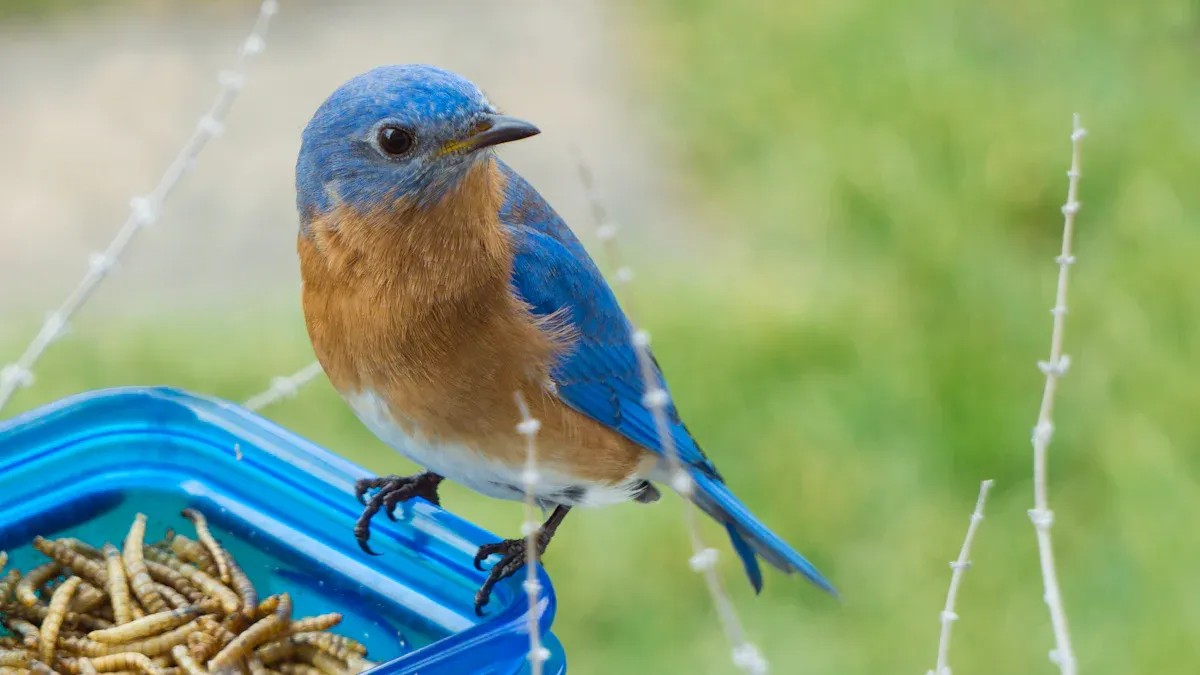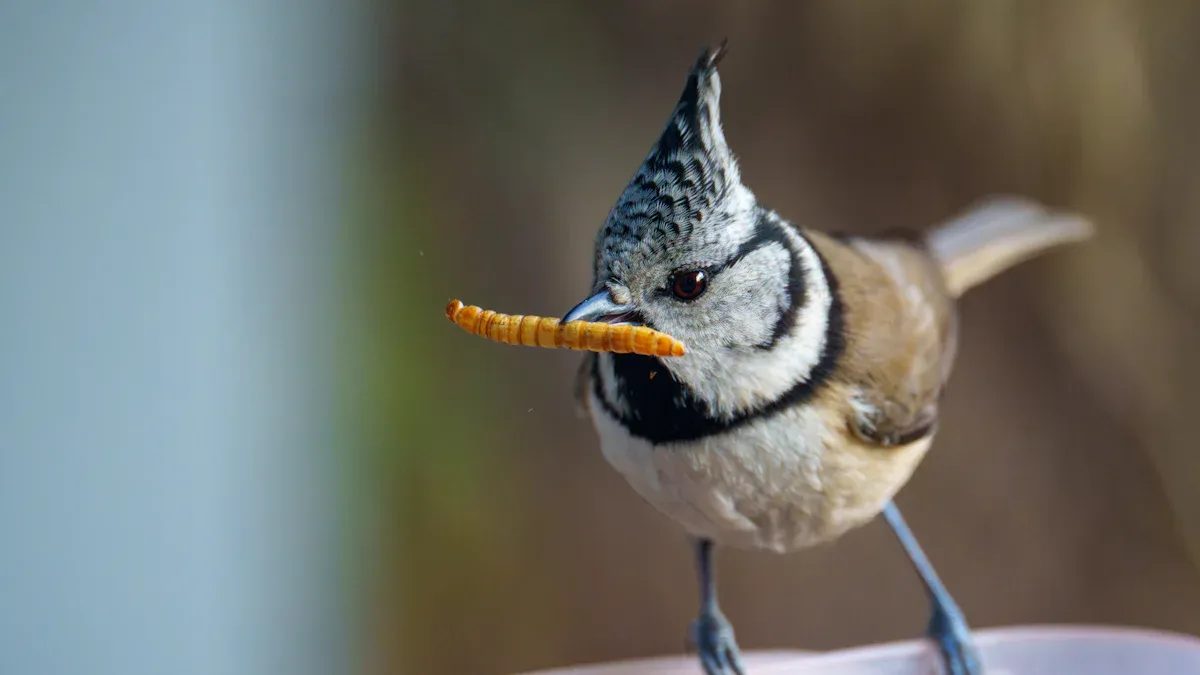
Bird enthusiasts know the joy of watching vibrant, active birds in their natural environment. Feeding dried mealworms to birds can make this experience even better. Packed with protein, fats, and amino acids, mealworms provide essential nutrients that promote energy, growth, and overall health. Studies even show they can aid digestion and reduce harmful bacteria in birds’ systems.
Key Takeaways
- Dried mealworms are high in protein, with about 50% protein. This gives birds energy, helps them grow, and builds muscles.
- Кормление сушеных червей keeps birds healthy. They have good fats and nutrients that help the brain and strengthen the immune system.
- Dried mealworms are simple to store and last a long time. They are easy to use and don’t need the care live mealworms do.
Nutritional Benefits of Feeding Dried Mealworms to Birds

High Protein for Energy and Growth
Protein is essential for birds to thrive. Dried mealworms are a powerhouse of protein, containing approximately 50% protein by weight. This high protein content plays a crucial role in supporting muscle development, feather growth, and maintaining energy levels. Birds expend a lot of energy flying, foraging, and staying active, so they need a reliable source of protein to keep up with their demanding lifestyles.
Did you know? Protein-rich diets are especially important for young birds during their growth phase and for adult birds during molting seasons when they need to regenerate feathers.
Compared to other bird feed options, dried mealworms stand out as a superior protein source. While black soldier fly grubs and superworms offer similar protein levels, mealworms are more widely available and easier to incorporate into bird feed. This makes feeding dried mealworms to birds an excellent choice for bird enthusiasts looking to boost their feathered friends’ energy and growth.
Essential Fats and Nutrients for Health
In addition to protein, dried mealworms are packed with healthy fats that birds need to stay in top condition. These fats provide a concentrated energy source, helping birds maintain their body temperature and fuel their daily activities. Fats also play a vital role in supporting brain function and overall health.
Mealworms also contain essential nutrients like amino acids, which are the building blocks of proteins. These nutrients contribute to a bird’s immune system, keeping them strong and resilient against diseases. While mealworms may lack the high calcium content found in black soldier fly grubs, they still offer a balanced nutritional profile that benefits most bird species.
| Nutritional Element | Mealworms | Superworms | Black Soldier Fly Grubs |
|---|---|---|---|
| Protein Content | 50-60% | Similar | Similar |
| Fat Content | 25-30% | Higher | Lower |
| Calcium Content | Low | N/A | 50x more than mealworms |
| Fiber Content | 7% | N/A | N/A |
This table highlights how mealworms compare to other options, showing their strengths in protein and fat content.
Fiber for Digestive Support
Fiber is another important component of a bird’s diet, and dried mealworms contain about 7% fiber. While this may seem like a small amount, it plays a big role in supporting healthy digestion. Fiber helps regulate a bird’s digestive system, ensuring they can efficiently process their food and absorb nutrients.
Birds that consume a diet with adequate fiber are less likely to experience digestive issues. This is especially important for wild birds, which often eat a variety of foods that may not always be easy to digest. By feeding dried mealworms to birds, you can help them maintain a balanced diet that supports their overall well-being.
Suitability for Different Bird Species

Birds That Benefit Most from Mealworms
Dried mealworms are a favorite among many bird species, but some benefit more than others. Bluebirds, for example, thrive on the high protein and fat content of mealworms. These nutrients are especially important during critical life stages, like when they’re feeding chicks or laying eggs. Bluebirds have even been observed feeding dried mealworms to their young, making them an excellent choice for bird enthusiasts hoping to support these vibrant creatures.
Other species, such as robins, wrens, and chickadees, also enjoy mealworms. During winter, when natural food sources are scarce, the extra fat in mealworms helps birds stay warm. In spring and summer, the protein supports growth and energy needs. This versatility makes feeding dried mealworms to birds a great way to attract a variety of species to your yard.
Wild Birds vs. Backyard Birds
Wild birds and backyard birds both benefit from mealworms, but their needs can differ. Wild birds often face harsher conditions and limited food supplies. Mealworms provide a reliable source of energy and nutrients, especially during migration or breeding seasons. Backyard birds, on the other hand, may have access to a wider range of food. Adding mealworms to their diet can still enhance their health and activity, making them more vibrant and energetic.
For birdwatchers, offering mealworms can attract a mix of wild and backyard species. This creates a lively and diverse environment, perfect for observing bird behavior up close.
Supporting Bird Health and Activity
Mealworms don’t just nourish birds—they also boost their activity levels. Studies show that even small amounts of mealworms can lead to higher activity across different bird species.
| Food Amount (g) | Bird Activity Level | Observed Species |
|---|---|---|
| 6.0 | Low | Most study species |
| Small amount | High | All study species |
This table highlights how mealworms can energize birds, encouraging them to forage, fly, and interact more. By incorporating mealworms into their diet, bird enthusiasts can support not only the health but also the liveliness of their feathered friends.
Practical Advantages of Feeding Dried Mealworms to Birds
Long Shelf Life and Easy Storage
One of the biggest perks of dried mealworms is their long shelf life. Unlike live mealworms, which require constant care and specific conditions to stay alive, dried mealworms can be stored for months without losing their nutritional value. This makes them a hassle-free option for bird enthusiasts who want to keep their bird feed fresh and ready to use.
Storing dried mealworms is simple. They come in resealable bags or containers that keep them dry and protected from pests. A cool, dry place like a pantry or cupboard works perfectly. No refrigeration or special equipment is needed. This convenience allows bird lovers to stock up on mealworms without worrying about spoilage or waste.
Tip: Always check the packaging for storage instructions to ensure your mealworms stay fresh for as long as possible.
Convenience Compared to Live Mealworms
Feeding dried mealworms to birds is far more convenient than dealing with live ones. Live mealworms require daily care, including feeding, cleaning, and maintaining the right temperature. For many people, this can feel like taking on an extra pet! Dried mealworms eliminate all that effort.
With dried mealworms, there’s no need to worry about wriggling insects or unpleasant odors. They’re ready to use straight out of the package. Whether you’re filling a feeder or sprinkling them on the ground, the process is quick and mess-free. This makes them an excellent choice for busy bird enthusiasts or anyone who might feel squeamish about handling live insects.
Fun Fact: Birds enjoy dried mealworms just as much as live ones, so you’re not sacrificing appeal by choosing the dried option.
Mixing Mealworms with Other Bird Feed
Dried mealworms work wonderfully when mixed with other bird feed ingredients. Combining them with seeds, nuts, or suet creates a balanced diet that meets a bird’s nutritional needs. While mealworms are rich in protein and fat, they lack calcium, which is essential for strong bones and eggshell production. Mixing them with calcium-rich options like black soldier fly grubs ensures birds get a well-rounded meal.
Here’s a quick comparison of nutritional values:
| Ingredient | Protein | Fat | Fiber | Calcium |
|---|---|---|---|---|
| Mealworms | 50% | 25% | 7% | Very little |
| Black Soldier Fly Grubs | Varies | High | High | N/A |
A balanced mix prevents birds from consuming too much protein, which can lead to health issues like gout. It also encourages a variety of birds to visit your feeders, as different species have different dietary preferences.
- Why mix mealworms with other feed?
- Mealworms provide high protein but low calcium.
- Excess protein can cause health problems.
- A balanced diet supports overall bird health.
By combining dried mealworms with other ingredients, bird enthusiasts can create a nutritious and appealing blend that keeps their feathered friends happy and healthy.
Environmental and Ethical Considerations
Sustainability of Dried Mealworms
Dried mealworms aren’t just good for birds—they’re also good for the planet. Studies show that producing mealworms uses far fewer resources compared to traditional protein sources like beef or chicken. For example, mealworm farming generates significantly lower greenhouse gas emissions and requires less land. This makes them a more sustainable option for those looking to reduce their environmental footprint.
Life cycle assessments have highlighted the eco-friendly nature of mealworm production. Unlike livestock farming, which demands large amounts of water and feed, mealworms thrive on minimal resources. They can even be raised on organic waste, turning leftovers into valuable protein. This innovative approach reduces waste and supports a circular economy.
Did you know? Mealworms need only 10% of the land required for beef production and 43% of the land needed for milk protein. That’s a huge difference in resource use!
By choosing dried mealworms, bird enthusiasts contribute to a more sustainable food chain. It’s a small change that can make a big impact on the environment.
Ethical Aspects of Using Mealworms
Mealworms offer ethical advantages over traditional feed sources. Their production involves fewer animal welfare concerns compared to raising livestock. Unlike cattle or chickens, mealworms don’t require large-scale farming operations that often lead to overcrowding or stress.
Here are some key ethical benefits of mealworm farming:
- Mealworms produce far fewer greenhouse gas emissions than livestock like pigs and cows.
- They require less land, reducing habitat destruction and preserving biodiversity.
- Farming mealworms avoids many of the ethical dilemmas tied to conventional animal agriculture.
Mealworms also align with the growing demand for sustainable and humane food options. Their low environmental impact and efficient farming methods make them a responsible choice for bird feed. By incorporating dried mealworms, bird lovers can support ethical practices while keeping their feathered friends healthy and happy.
Feeding dried mealworms to birds offers a host of benefits. Their high protein and fat content boost energy and health, while their versatility attracts a variety of bird species. Practical advantages like easy storage and sustainability make them a smart choice for bird enthusiasts. Studies even show long-term health improvements in birds fed mealworms. Why not give them a try?
Birds thrive on balanced diets, and dried mealworms are a perfect addition to any bird feed mix.
Article by Felix
FAQ
What types of birds eat dried mealworms?
Many birds enjoy dried mealworms, including bluebirds, robins, wrens, and chickadees. These species benefit from the high protein and fat content.
How should dried mealworms be stored?
Store dried mealworms in a cool, dry place. Use resealable bags or containers to keep them fresh and protected from pests. No refrigeration is needed.
Tip: Check packaging for specific storage instructions!
Can dried mealworms replace other bird feed?
Dried mealworms work best as a supplement. Combine them with seeds, nuts, or suet for a balanced diet that meets birds’ nutritional needs.
🐦 Birds love variety in their meals!


